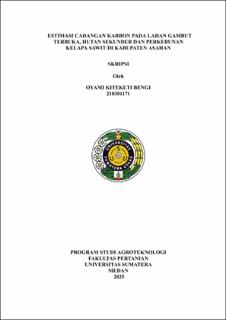Estimasi Cadangan Karbon pada Lahan Gambut Terbuka, Hutan Sekunder dan Perkebunan Kelapa Sawit di Kabupaten Asahan
Estimation of Carbon Reserves in Open Peatland, Secondary Forest and Oil Palm Plantations in Asahan Regency
Abstract
Peat soils with various land covers have great potential as carbon storage and play an important role in climate change mitigation. The types of plants that exist in peat areas vary according to the conditions or management of the peat. Generally, woody trees in secondary forests to monoculture crops that affect the physical and chemical properties of the soil. The research was conducted in March-June 2025, aiming to determine the influence of Open Peatland, Secondary Forest and Oil Palm Plantations on the amount of carbon stock in Asahan Regency, North Sumatra Province. The first location was at the Bangun Village Oil Palm Plantation, Pulau Rakyat Sub-district for the peat area. The second location is in Alang Bonbon Village, Aek Kuasan District for Open Peat and Secondary Forest. Soil samples were taken purposively at a depth of (0-30 & 30-60 cm) with three points from each area. The analysis parameters included bulk density, moisture content, organic carbon, peat maturity, and carbon reserves. The results showed that the highest carbon stock values at depths of (0–30 & 30–60 cm) were found on plantation land, namely 373.62 tons/ha. Secondary forests were below that with a carbon stock value of 294.37 tons/ha, and the lowest was on open land at 276.98 tons/ha. Differences in parameter values are influenced by the level of peat maturity and human activities such as land clearing and management. Peatland clearing for oil palm should be done without burning. Maintaining natural vegetation is good, followed by shallow drainage systems and maintaining ground cover plants.
Collections
- Undergraduate Theses [3569]

